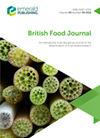浪费食物的五种方式:食物浪费行为问卷
IF 3.4
3区 经济学
Q1 AGRICULTURAL ECONOMICS & POLICY
引用次数: 0
摘要
本研究的目的是解决当代评估消费者食物浪费方法存在的两个问题:缺乏既定的食物浪费行为类别和评估食物浪费的困难。在研究1a和1b中,开发了一个测量食物浪费行为的五因素问卷。研究2和探索性分析验证了问卷是否可以预测浪费的肉类,乳制品和面包店的数量以及一系列社会经济特征。设计/方法/方法基于预先登记的研究,制定了一份新的测量食物浪费行为频率的问卷——食物浪费行为问卷(FWBQ)。研究结果表明,与食物浪费有关的行为可以归纳为五种不同的基本类别:(1)因为食物“不好吃”而丢弃食物;(2)通过只购买必需品来防止食物浪费;(3)通过规划防止食物浪费;(4)通过分享防止食物浪费;(5)通过饲养动物防止食物浪费。FWBQ允许调查影响食物浪费行为的社会经济因素。最后,FWBQ允许预测浪费的肉类,乳制品和烘焙产品的数量。此外,特定因素与一系列社会经济特征有关。独创性/价值FWBQ已被证明是一种廉价且易于使用的方法,用于将不同类别的食物浪费行为系统化并展示其决定因素。该研究采用实证方法(而不是直觉)来区分不同类别的食物浪费。本文章由计算机程序翻译,如有差异,请以英文原文为准。
Five ways to waste food: food wasting behaviours questionnaire
PurposeThe goal of the present research was to resolve two problems with contemporary methods used to assess consumer food waste: the lack of established categories of food wasting behaviours and difficulties in assessing food waste. In Studies 1 A and 1 B, a five-factor questionnaire for measuring food wasting behaviours was developed. Study 2 and Exploratory analyses verified whether the questionnaire allows for predicting the amount of wasted meat, dairy and bakery and a range of socioeconomic characteristics.Design/methodology/approachBased on pre-registered studies, a new questionnaire for measuring the frequency of food wasting behaviours, the Food Wasting Behaviours Questionnaire (FWBQ), was developed.FindingsThe results provided evidence that behaviours associated with food wasting could be narrowed down to five distinctive basic categories: (1) discarding food because of its' unpalatability; (2) preventing food waste through buying only the necessities; (3) preventing food waste through planning; (4) preventing food waste through sharing and (5) preventing food waste through feeding animals. The FWBQ allowed for investigating the socio-economic factors that influence food wasting behaviour. Finally, the FWBQ allowed for predicting the amount of wasted meat, dairy and bakery products. Also, particular factors were associated with a range of socioeconomic characteristics.Originality/valueThe FWBQ has been shown to be an inexpensive and easy-to-use method for systematising distinct categories of food wasting behaviours and demonstrating their determinants. The study takes an empirical approach (rather than intuitive) to distinguish separate categories of food wasting.
求助全文
通过发布文献求助,成功后即可免费获取论文全文。
去求助
来源期刊

British Food Journal
工程技术-食品科技
CiteScore
6.90
自引率
15.20%
发文量
219
审稿时长
18-36 weeks
期刊介绍:
After 115 years, the British Food Journal (BFJ) continues to be highly respected worldwide for its broad and unique interdisciplinary coverage of the latest food-related double blind peer-reviewed research. It links all sectors of this dynamic industry, keeping abreast of emerging trends, topical and controversial issues and informing and stimulating debate. - See more at: http://emeraldgrouppublishing.com/products/journals/journals.htm?id=bfj#sthash.O3wH4pEh.dpuf
 求助内容:
求助内容: 应助结果提醒方式:
应助结果提醒方式:


